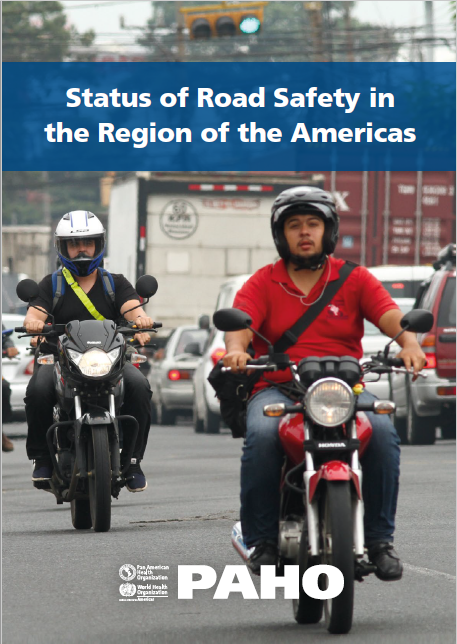New PAHO report calls for urgent measures to reduce road traffic deaths among children, adolescents and young people
 A new report from the Pan American Health Organization (PAHO) reveals that the number of road traffic deaths continues to rise in the Americas, reaching almost 155,000 per year, 11% of the world’s total. The report, “Status of Road Safety in the Region of the Americas”, highlights that road traffic injuries are the leading cause of death for children aged 5 to 14 years, and the second highest cause of death for young people aged between 15 and 29 years. It is also the tenth highest cause of death for all age groups.
A new report from the Pan American Health Organization (PAHO) reveals that the number of road traffic deaths continues to rise in the Americas, reaching almost 155,000 per year, 11% of the world’s total. The report, “Status of Road Safety in the Region of the Americas”, highlights that road traffic injuries are the leading cause of death for children aged 5 to 14 years, and the second highest cause of death for young people aged between 15 and 29 years. It is also the tenth highest cause of death for all age groups.
“These findings indicate the need to prioritize the prevention of these injuries with proven interventions that we know work,” said Dr. Carissa F. Etienne, Director of PAHO. “Road traffic injuries not only take the lives of thousands of people each year, but they also leave thousands more with disabilities, emotional and financial distress, and place a heavy burden on health services.”
Regional panorama
This report presents the latest data on mortality (2016), legislation (2017), evaluation of roads (2017) and vehicle standards (2018) reported by 30 countries in the Americas. It highlights that while there have been advances in road safety legislation and management, and follow-up care for those affected, the goal of reducing road traffic deaths by half by 2020 will not be achieved.
With 15.6 deaths per 100,000 people, the Americas has the second lowest road traffic fatality rate compared to other WHO regions. However, there are variations between subregions and countries. The Latin Caribbean Region (21.1 deaths per 100,000 inhabitants), the Andean Region (20.9), the Southern Cone (which managed to reduce its rate from 20.9 in 2013 to 18.4 in 2016), and the non-Latin Caribbean (16.7) all had higher road traffic fatality rates, while Mesoamerica (14.2) and North America (11.7) reported lower road traffic fatality rates.
Fatality rates vary from country to country and are also influenced by levels of development. According to the report, road traffic fatality rates in Barbados and Canada are less than half the regional average (5.6 and 5.8 per 100,000 population, respectively), while St Lucia and the Dominican Republic have double the regional fatality rate (35.4 and 34.6, respectively).
Motorcyclists, pedestrians and cyclists are the most affected
Almost half of those who die due to road traffic injuries are motorcyclists (23%), pedestrians (22%) and cyclists (3%), who are considered vulnerable road users because they have minimum protection and no alternative but to use unsafe road infrastructure. The percentage of motorcycle victims increased from 20% to 23% between 2013 and 2016, which is likely related to a 23% increase in the number of registered 2 and 3-wheeled vehicles during the same period.
Limited advances in legislation
The report analyzes advances in national legislation that address the five key risk factors to prevent road deaths and injuries. These include speeding, drink-driving, and failing to use seatbelts, motorcycle helmets and child restraint systems.
Since 2014, two additional countries – the Dominican Republic and Uruguay, implemented laws on driving under the influence of alcohol, which brings the total number of countries to eight. Ecuador implemented legislation on the use of helmets (seven countries in total). The Dominican Republic implemented legislation on the mandatory use of seatbelts (19 countries in total), while Chile implemented laws on the use of child restraint systems (two countries in total).
However, no new laws have been enacted on reducing speed limits, a key measure that saves lives, with only five countries ensuring standards that align with best practices (introducing maximum speed limits of 50 kilometers per hour on urban roads).
“The enactment of laws, and their effective enforcement, are key to preventing road traffic deaths. However, this remains a challenge for most countries,” said Eugenia Rodrigues, Regional Advisor on Road Safety at PAHO. Rodrigues also stressed the importance of having road safety agencies, which exist in 29 of 30 countries in the Region, as well as coordination and collaboration between various sectors.
The report also evaluates the status of vehicle safety regulations and road infrastructure and analyzes the progress and challenges towards improving post-crash care.



